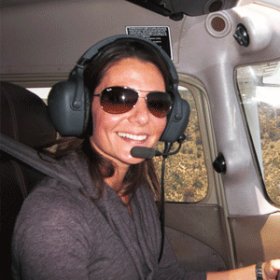
How to become Private pilot?
 People who love flying really love flying. Pilots are those people — thanks largely to the allure of the tight-knit community that comes with the freedom to travel solo in the air up there.
People who love flying really love flying. Pilots are those people — thanks largely to the allure of the tight-knit community that comes with the freedom to travel solo in the air up there.
The easiest flight certification to get is a private pilot’s license, which means flying a small, personal small aircraft, along with the ability to bring passengers without charging anyone money for flight services.
But getting paid isn’t why these pilots fly, anyhow. These pilots fly because they love it. With a passion. And there are unique bonuses that come with it…
Here are 8 air-mazing activities to enjoy with a private pilot’s license!
8: Join a Flying Club.
A flying club is a great way for pilots with a private certificate to team up with other pilots and spread out the costs of owning and operating an airplane. Most club members will tell you the lifelong friendships with other people also in love with flying are pretty awesome too.
There are two main kinds of flying clubs:
- Corporate clubs – owners rent their planes out to a second tier of members who pay a membership fee, typically on a monthly basis.
- Partnership clubs – four owners share the aircraft, exclusively.
Rookie pilots who are limited in experience pertaining to maintaining or financing an aircraft are often better off involved in a corporate gig. This is a relatively inexpensive option for renting aircraft, while also relieving users of more involved maintenance responsibilities, typically taken care of by the owners’ circle.
On the flip side, there’s something to be said about owning your own plane — even if that means sharing it with three of your best buddies. The partnership route can be rewarding, as long as the “aircraft allocation” details are clearly defined beforehand (i.e., who pays for what, when does so-and-so get to use the plane, who handles maintenance, etc.). You get the idea.
 7: Be a Tour Guide.
7: Be a Tour Guide.
It’s nearly impossible to put a price on new or extraordinary experiences. Sharing a unique hobby with others is often a rare and priceless opportunity. But flying is a creative chance to do just that.
As a pilot with a private certificate you cannot, by law, charge a fee for giving people rides in your aircraft. There’s a big, bold, government-regulated line between what’s permissible with commercial versus private pilot certificates. And charging for flights falls strictly within “commercial pilots only” territory.
This restriction doesn’t mean, however, that non-certified friends or family who join you for a recreational flight as a passenger can’t oh-so-generously chip in on gas money. (*Wink, wink!*)
As Tim Morgan, a privately certified pilot in the Bay Area, advises: “Some of your friends will be scared of flying. Some will be ambivalent. Some will be thrilled for a chance to go with you. Whatever the case, most pilots are more than extremely eager to share their love of flying with their friends. Usually passengers disembark saying, ‘That was so cool!‘ Then posting all their photos on Facebook.”
 Tim created a website, Flightseein’, to help private pilots demonstrate the unparalleled experience of flying with friends using a ‘visual logbook’ to record and share flight videos. With it, even the biggest couch potatoes have been swayed to give in and enjoy an unforgettable ride. Or even sign up for flying lessons themselves!
Tim created a website, Flightseein’, to help private pilots demonstrate the unparalleled experience of flying with friends using a ‘visual logbook’ to record and share flight videos. With it, even the biggest couch potatoes have been swayed to give in and enjoy an unforgettable ride. Or even sign up for flying lessons themselves!
6: Master Your Region.
Of course, being a local tour guide is great, but being able to cover an entire region for business or pleasure is a completely different level of flying. “Cross-country flying” (or taking off from one airport, and landing at a different one some distance away) is an unrivaled freedom that a private pilot’s license can offer.
There are additional certifications that a private pilot can earn after obtaining basic private license. These add-ons start with an instrument rating, and they advance up through to a commercial pilot’s license. And yes, some recreational pilots do choose to complete commercial certification (even if they don’t plan to fly for a living) because it hones safety skills and flying techniques.
Achieving additional certifications and logging flight hours are the two keys to becoming the master of a region. Each takes a substantial dedication to your hobby and a noteworthy time commitment. But the payoff of freedom and convenience (being able to get anywhere within 1, 000 miles of your home airport-base within a single day) is an indisputable reward to be reaped.
5: Learn Aerobatics.
Aerobatics are flying stunts: loops, barrel rolls, tail spins, steep dives. All of which add a serious dose of adrenaline to a flying experience. Gunning to become the next Red Baron? Anyone holding a private pilot’s license is eligible to formally train in aerobatic maneuvers. (Just so long as his/her stomach can tolerate the G-Force generated by pulling these types of tricks, thanks to good ol’ gravity.)
The wonderful world of aerobatics even comes with a governing body, known as the International Aerobatic Club (IAC). The IAC enables daredevil pilots to qualify for various levels of trick-turning expertise, as well as partake in high-flying lessons and competitions all over the world. So if you think you’ve got it, by all means, flaunt it while you fly.
4: Build Your Very Own Plane.
Yes, you read that right! Believe it or not, you are permitted to build your very own plane. And then fly it. With licensing, of course. Which is yet another reason why getting private pilot’s certification is an incredible feat.
And like much of the aviation world, strong community ties naturally exist within the “home builder” aircraft movement, complete with supporting organizations like the Experimental Aircraft Association (EAA).
Over the years, a surprising number of folks have built their own airplanes out of sheer hobby-loving motivation — spending night after night toiling in the garage, poring over diagrams, and investing hours in the great hunt for parts.
While a lot of tinkerers don’t mind taking their time to plug away at constructing their masterpiece, companies have popped up offering fast and efficient assistance in personal plane building. That’s right, with the help of companies like Glasair Aviation, you can build a turbocharged, carbon-fiber airplane in about two weeks.
The aviation experts at Glasair have taken all of the part-searching, tool-finding, and diagram-assessing out of the equation, allowing pilots to focus solely on piecing the plane together. Safely. And still in record time.









